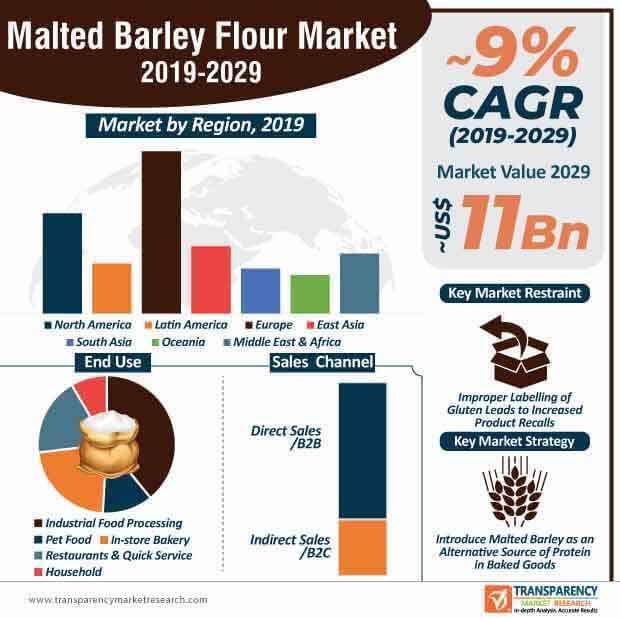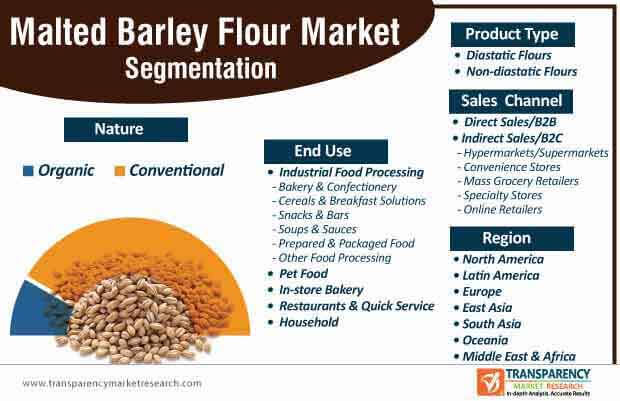
Craft Brewing and Clean Label Product Manufacturers Target Health-conscious Consumers
The growing number of health-conscious consumers has encouraged companies in the malted barley flour market to develop products with clean label malted ingredients. For instance, Muntons – a supplier of malted ingredients for the worldwide F&B industry, manufactures high-quality clean-label malt ingredients targeted at health-conscious consumers. This trend has bolstered the output of malted barley flour market which is expected to reach ~7,382,500 metric tons by the end of 2029.
The brewing industry is one of the key focus points for companies in the malted barley flour market, owing to the rapidly growing craft brewing movement worldwide. Companies are investing for the development of new production facilities that can specially focus on brewing applications. They are making bold investments to incorporate test breweries, test kitchens, and conference facilities to help stakeholders have an interactive approach toward innovations in craft brewing. These investments have helped market players to closely identify the needs of their customers.

Request a sample to get extensive insights into the Malted Barley Flour Market
Brainstorming Sessions and Collaborations with Food Technologists Lead to Product Innovations
The Europe malted barley flour market is flourishing due to the emergence of new production facilities of leading market players. As such, the malted barley flour market in Europe is projected for aggressive growth. The region is estimated to lead the malted barley flour market during the forecast period.
The trend of home beer making has driven investments in state-of-the-art product development and innovation facilities. Companies in Europe are strengthening their supply chains by developing malted barley flour products, kibbles, flakes, and flour blends to meet consumer requirements. They are inviting potential customers to book the facilities in order to conduct brainstorming sessions with in-house bakers, head brewers, and food technologists to gain insights on changing consumer preferences. On the other hand, companies are introducing malted barley in baked goods as an alternative source of protein.
To understand how our report can bring difference to your business strategy, Ask for a brochure
Malted Barley Flour versus Spent Grains: Which is better?
Spent grains are gaining popularity due to their low-sugar/starch content and are high on fiber and protein. However, malted barley flour has small amount of fiber as compared to spent grains. Hence, companies in the malted barley flour market are increasing awareness about the enzymatic activity of the flour in the production of baked goods that provides desired results to end users. Thus, manufacturers are creating revenue streams by increasing the production of sweeter bread products, doughnuts, cakes, and the likes. This trend has led to exponential growth of the malted barley flour market, which is anticipated to progress at a healthy CAGR of ~9% during the forecast period.
Companies are creating stable business streams by tapping opportunities in bakery products segment. As such, bakery & confectionary sub-segment is projected to lead the in industrial food processing segment. On the other hand, spent grains are gaining popularity for their high-fiber attributes, contributing toward reduced ecological footprint.
Diverse Segments such as Pet Food Create Incremental Opportunities for Companies
The malted barley flour market is expected to reach the global revenue of ~US$ 11 Bn by the end of 2029. However, improper labeling of gluten-containing malted barley flour has led to incidences of product recalls. For instance, Premier Foods-a British food company, announced product recalls for Hovis Granary Bread Flour, since it contained gluten and was not mentioned on the label. This issue is likely to slow down market growth. Hence, manufacturers in the malted barley flour market are adopting ‘full-ingredient’ labels to avoid the issue of misleading labeling and prevent incidence of product recalls.
Apart from bakery & confectionary, producers are leveraging incremental opportunities in diverse segments such as pet food and breakfast cereals. Lately, pet owners are growing increasingly aware about gastrointestinal and joint problems of animals. In order to avoid such health issues in pets, pet parents are opting for products with malted barley flour to maintain optimum health of their animals.

Stuck in a neck-to-neck competition with other brands? Request a custom report on Malted Barley Flour Market
Analysts’ Viewpoint
Continuous growth of the malted barley flour market largely contributes to the number of fragmented market players, which account for ~55-60% of the market stake. This has enabled innovations in craft brewery. Moreover, high prevalence of millennial population has contributed to the business of craft brewery with the growth of HoReCa, especially in developing economies of East and South Asia.
Bakery & confectionary is one of the key focus segments of producers. However, improper labelling of gluten in malted barley flour products has led to issues of product recalls. Hence, companies should adopt ‘full-ingredient’ labeling to prevent product recalls. Companies should explore untapped opportunities in Latin America and Middle East & Africa, since the malted barley flour market is predicted for exponential growth during the forecast period.
Malted Barley Flour Market: Overview
- The global malted barley flour market value stood at ~ US$ 4.7 Bn in 2019, finds Transparency Market Research (TMR) in a recent study. According to the report, the market is anticipated to reach ~US$ 11 Bn by 2029, at a CAGR of ~9%.
- The increasing demand for bakery and RTE products is a key factor responsible increasing sales of malted barley flour. Apart from this, the change in food habits of consumers is fueling the demand for malted barley flour in the food and beverage industry.
Malted Barley Flour: Market Frontrunners
- Based on product type, diastatic flour was the leading segment in 2019 accounting for approximately ~85.2% of the market share. Furthermore, the non-diastatic flour segment accounted for 14.8% of the market in terms of value.
- By nature, the conventional malted barley flour is the prominent segment; however, the organic malted barley flour segment is anticipated to show growth at a higher rate as compared to conventional malted barley flour.
- Europe is leading the global malted barley flour market followed by North America and South & East Asia. Europe accounts for around 37.3% share in the global market.
- On the basis of the sales channel, the B2B segment holds approximately 71% of the total market share, whereas the B2C segment holds the remaining market share in the global malted barley flour. Online retailing is gaining popularity among the sales channel in recent years.
More Trending Reports by Transparency Market Research – https://www.prnewswire.com/news-releases/global-dairy-alternatives-market-to-reach-valuation-of-whopping-us-34-6-bn-by-2029-transparency-market-research-301000215.html
Malted Barley Flour Market: Trends
- The organic trend has become very popular in the food & beverages industry. Additionally, the demand for organic food is very high in developed as well as in developing regions. As organic products do not contain any synthetic chemicals, customers prefer them more than conventional products. Manufacturers of malted barley flour have started offering organic flour since it is highly nutritive and is labelled GMO-free. According to the 2014 survey released by NASS (the U.S. Department of Agriculture’s National Agricultural Statistics Service), there are approximately 14,000 certified organic farms in the United States that valued around US$ 5.5 Bn from the organic products in 2014, which is a rise by 72% since 2008. This statistics shows that the demand for organic products is gaining traction. Hence, the manufacturers, as well as new entrants in the malted barley flour market, should also focus on the launching of organic products to catch hold the large consumer base.
Health Benefits Associated with Malted Barley Flour to Augment Sales
- Multiple health benefits are associated with the consumption of malted barley flour. Some of these health benefits are reduction in cholesterol level and triglycerides. Malted barley flour consumption also helps in preventing arteriosclerosis, which leads to coronary disease. Malted barley flour helps to reduce the risk of certain intestinal disorders. For instance, the fiber present in barley helps to prevent constipation and its complications. Malted barley flour is highly recommended by doctors for patients suffering from indigestion, colitis, gastroenteritis, and gastroduodenal ulcer. Increasing awareness about health benefits associated with malted barley flour is will therefore enable growth in the market.
- Manufacturers are emphasizing on attracting consumer focus to health benefits of malted barley flour during the marketing and promotional activities, which will rapidly boost the consumption of malted barley flour
Malted Barley Flour Market: Strategies
- Key manufacturers operating in the global market are focusing on new product launches to attract a huge consumer base. Customers easily get fascinated by those companies/brands that offer products with innovations, and have improved product quality and taste.
- Marketing Campaign: Apart from innovations, manufacturers are investing in various marketing activities for their product promotion
Request for covid19 Impact Analysis – https://www.transparencymarketresearch.com/sample/sample.php?flag=covid19&rep_id=75939
Target Region for Market
- Europe has emerged as a dominant market holding the largest share of the global malted barley flour market in 2019. It is anticipated to remain at the top position in the market during the forecast period. However, this market in Oceania and Latin America is estimated to show higher rate of growth in the forthcoming years.
Malted Barley Flour Market: Players
- Key players operating in the market, as profiled in the study,
- Archer Daniels Midland Company
- Ardent Mills, LLC
- IREKS GmbH
- Muntons plc.
- Briess Malt & Ingredients Co.
- Imperial Malts Ltd
- The Malt Company Private Limited
- Munari F.lli s.p.a
- Maltexco S.A
- Mirfak Pty Ltd.
- Miller Milling Company
- Cereal & Malt Extract (Pty) Ltd.
- Edme Limited
- Galletti S.n.c.
- Cereal Food Manufacturing Company, among others





